
14 minute read
Status Forestry & Forest Products Research Australia & PNG 1947
from PNGAF MAGAZINE ISSUE # 9D4D of 15th March 2022 - global timeline forest tree plantations
by rbmccarthy
1947 History of Research Work in Forestry and Forest Products in Australia and PNG. (Extracts article by G Rodger Unasylva Vol 1 # 3 Nov-Dec 1947 FAO)
Research in forestry may be said to have been carried out from the earliest days of Australia's settlement, although in the beginning it consisted largely of systematic botanical investigations and experiments in the development of exotic trees.
Advertisement
About 1919 the Commonwealth Institute of Science and Industry formed the
Forest Products Laboratory. The activities of this institution, which were confined to chemical investigations, laid the foundation for the establishment of the tannin-extraction industry in Western Australia and of the Australian pulp and paper industry in the eastern states. Much of the work of the original laboratory was done in co-operation with the Western Australia Forests Department; and when in 1926 the Institute of Science and Industry was replaced by the Council for Scientific and Industrial Research, this co-operative work was continued without a break, although there was a lapse of three years before the new CSIR Division of Forest Products was created.
At the eighteenth meeting of the Australian Association for the Advancement of Science, held in Perth, Western Australia, in 1926, the following resolution was passed: In the opinion of the Council there is need in every State of Australia for more systematic investigation of those Forestry problems which come under the heads of Silviculture and Forest Management. A central coordinating authority is necessary if this work is to be carried out satisfactorily. The Council suggests that the Commonwealth Government having established an Australian Forestry School might with advantage extend the scope of the work by embracing general research into Forestry problems.
The Commonwealth Forestry Bureau was established at Canberra ACT in
1927, and it was decided that in addition to its other functions the Bureau should undertake responsibility for initiating and carrying out investigation and research in three main divisions of forestry: silviculture, forest management, and forest protection.
In 1928 initial steps were taken to institute forestry research under the Commonwealth Forestry Bureau by the appointment of research scholars in silviculture, management, and forest engineering. These research scholars underwent a short course of training at the Australian Forestry School, Canberra, before proceeding abroad for more advanced studies. On the completion of their course abroad they returned to Australia and were engaged in various branches of forestry research work. The Bureau received parliamentary sanction in 1930 by the Forestry Bureau Act No. 16. The field research work suffered severely as a result of the depression years. Of the initial staff of four officers, three were lost to other services. For several years, the work was carried on with the assistance of the staff of the Australian Forestry School. In 1935 the national recovery made an extension of the work possible and in 1937 a staff of three qualified men and five assistants was engaged on research work.
In 1938 a research station was established in the southeast of South Australia,
in co-operation with the Woods and Forests Department of that state, to undertake work on problems connected with the forests of the district and to extend the work being carried out at the main research station in the Australian Capital Territory.
In January 1941, a joint arrangement was entered into with the Tasmanian Forestry Department by which the Bureau established a branch of the research organization in Tasmania; but owing to the war the work of this station had to be suspended early in 1942, and the officer in charge was seconded to the Tasmanian Forestry Department until the cessation of hostilities.
Forestry and Timber Bureau 1946
In 1946 the Forestry Bureau was reconstituted as the Forestry and Timber Bureau under a director-general. Its research functions were extended to cover the supply, production, distribution, and use of timber and incorporating the timber planning and co-ordinating responsibilities of the wartime organization of Commonwealth Timber Control, which lapsed 31 December 1946.
The functions of the Forestry and Timber Bureau were to advise the-Administrations of the Territories on all matters pertaining to the management of forests; to manage forests placed under its control by the Governor-General; to establish experimental stations for the study of silviculture, forest management, and forest protection; to provide educational facilities for the training of professional foresters; to establish and award forestry scholarships; to collect and distribute forestry information;. To publish reports and bulletins dealing with forestry.
The Forestry and Timber Bureau comprised five main divisions: (1) Forestry Education (Australian Forestry School); (2) Forest Research, (3) Forest Resources; (4) Timber Statistics and Planning; and (5) Administration and Management.
Division of Forest Products, CSIR 1929
Following the replacement in 1926 of the Institute of Science and Industry by the Council for Scientific and Industrial Research, the Division of Forest Products came into being in 1929. Before the formation of this Division, two young graduates were selected and sent overseas for training at the United States Forest Products Laboratory. This policy was continued for several years until there was at least one officer soundly trained in each branch of forest products research. The first two of these to return to Australia, together with several officers having forest products research experience in state departments in Australia, formed the original staff of the Division. Owing to lack of central facilities this small staff was at first scattered, one member-remaining in Western Australia, one working in Canberra, A.C.T., and the rest in Melbourne, Victoria.
This was the first Division of the Council for Scientific and Industrial Research to devote its activities to secondary industry. Lacking research facilities in the first instance, much of its initial work consisted of surveying the needs of the Australian timber industry and of conducting an educational campaign throughout the industry along the lines of sound practice in timber seasoning and general factory procedure.
State Forestry Departments. Each state has its own forestry department, responsible under the government of the state for the administration of the forests within its own boundaries. As a result of the growing demand for investigation and research into many problems of forestry and forest products, the state governments through their forestry services have in recent years considerably expanded their research activities on problems associated with the growth and protection of their own forests; the establishment of plantations of exotic trees, particularly conifers; and the utilization of forest products
Other State Governmental and Semigovernmental Bodies. In several states research work in the field under review is also carried out by other state governmental or semigovernmental bodies and officers, such as universities, government botanists and entomologists, and departments of agriculture, in co-operation with the State Forestry Departments.
Private Companies and Organizations. In connection with their industrial requirements, various private organizations, principally pulp and paper companies, have conducted considerable research into the utilization of the native timber species and to some extent of plantation-grown exotics.
Funding
The research activities of both the Forestry and Timber Bureau and the Division of Forest Products are financed annually on a Commonwealth Government vote of funds.
The Division of Forest Products, the vote of funds provided by the government is supplemented by regular fixed grants from the three Australian paper companies.
Research work by the various state forestry departments is mainly financed by a yearly vote of funds by the state governments. In some cases, finance is provided from reforestation funds under the administration of the forestry departments and also from loan funds made available by the state governments. Private companies and organizations provide their own funds for research.
Forestry Research Work and Results
Forestry and Timber Bureau Canberra, A.C.T. Sections include Silviculture, Plant Physiology, Dendrology, Nutrition, Genetics, Factors Influencing the Form of the Tree Trunk, Nursery Technique, Pruning, Arboreta, Seeds, Forest Management, Forest Protection
State Forestry Departments. All states of the Commonwealth carry out research in connection with their normal work of silviculture, management, protection, and utilization. This includes: (1) studies in the phenology and natural regeneration of the native species; (2) studies in nursery technique and the establishment of both native and exotic species; (3) pruning and thinning practices; (4) collection of information regarding growth and yield and the determination of site qualities; (5) investigations in connection with fire control, forest pathology, and forest entomology; (6) logging studies
Division of Forest Products, CSIR. The following summary indicates the main types of work carried out by the various sections of the Division.
Wood Structure Section. - This Section has made a comprehensive study of the macroscopic and microscopic characteristics of Australian timbers and has applied the results of its work to identification keys on the one hand and to certain features of investigation of other sections on the other. During World War II, card-sorting keys developed for the timbers of the Pacific Islands were of considerable aid to the Allied forces fighting in that zone.
Wood Chemistry Section. – continues the work of the pulp and paper investigations initiated by the old Forest Products Laboratory.
Timber Physics Section. - In addition to purely fundamental research into the physical properties of timber, this Section has carried out valuable work in connection with the selection of suitable timbers for such specialty uses as battery separators.
Timber Mechanics Section.
- Its earlier work on the mechanical properties of various Australian timbers made it possible, when World War II began, for this Section to suggest species worthy of further test for such critical uses as aircraft construction, and during the war the whole of its effort was devoted to mechanical tests of timber and plywood for such uses. Other major projects include a study of the bending properties of Australian timbers and, more recently, projects designed to meet the need of materials for housing.
Seasoning Section. – Major activity was developing a high standard of kiln drying in Australia. In 1929, timber-drying kilns in this country were relatively few and, for the most part, inefficient. Mainly because of the activities of the Timber Seasoning Section, kiln drying is established practice throughout the Commonwealth and most kilns been built to designs provided by the section. Further, many kiln operators have either been trained in the Section or have taken its correspondence course in kiln operation. The section has also ears undertaken several major projects related to utilization problems, the most important of these being sawmill studies and investigation of sawdust-cement and wood-wool-cement mixtures.
Preservation Section. - Some of the earliest projects of the Division were concerned with field tests of poles, sleepers, and fence posts treated with various preservatives. These are still in progress, but some valuable information has been obtained already, The Section was responsible for the boric acid treatment of lyctus-susceptible timbers, a process which has now been adopted in both Queensland and New South Wales and is made compulsory for certain timbers in the latter state. Original work towards a systematic study of wood-destroying fungi was interrupted by the war but is now being resumed.
Veneer and Gluing Section. - Assistance in the peeling, drying, and gluing of Australian timbers. Work on adhesives is taking an increasingly important place in its program.
Utilization Section. - Dealing with production problems in general, this section applies information obtained by the other sections and gives advice to the industry in accordance with the data so gathered.
Dr Eric Dadswell Yalu Forest Resource Workshop July 1944 photo credit Linda Cavanaugh Manning.
An example below of a card sorting system like that Dadswell produced for timbers of New Guinea and neighbouring islands in 1940’s.
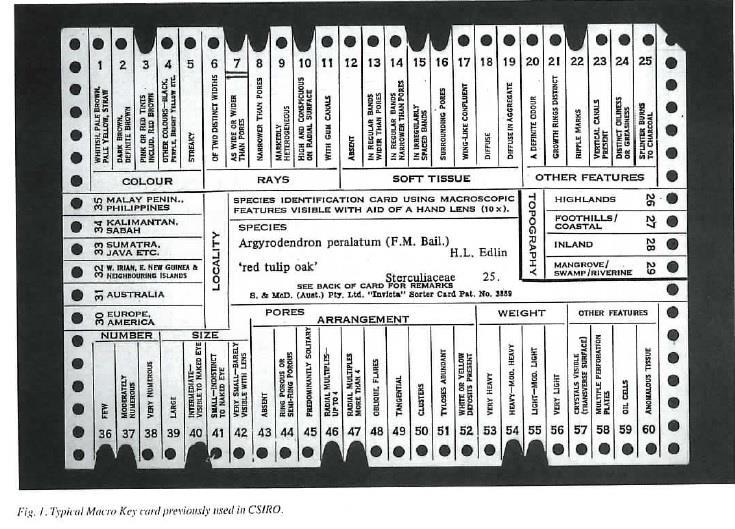
State Forestry Departments. All the state forestry services carry out investigations with a view to improving utilization and extending the field of uses for the different species. They are also actively engaged in investigations covering mill studies, timber grading, seasoning, preservation, and other treatment as well as general utilization economics. In New South Wales and Queensland, the forestry departments maintain sections carrying out detailed research work in connection with the characteristics, properties, and uses of timbers growing in their own states.
Private Companies and Organizations. Considerable research in the utilization of forest products for commercial purposes has been carried out by various private companies and organizations. The chemical investigations in Western Australia resulted in the establishment of the tannin-extract industry in that state, were carried out in cooperation with a private firm. The research work on distillation of sandalwood oil and perfume from flowers of Boronia megastigma was also carried out by private companies in association with other organizations.
The major research work has been carried out by the pulp and paper companies. Australian Paper Manufacturers, Ltd., operating in Victoria, producing kraft paper from eucalypt timbers; Associated Pulp and Paper Mills, Ltd., operating in Tasmania, producing fine writing and typing papers from eucalypt timbers; Australian Newsprint Mills Pty., Ltd., operating in Tasmania, producing newsprint; Cellulose Australia, Ltd., operating in South Australia, producing paperboard from planted forests of radiata pine; Masonite Corporation (Australia), Ltd., operating in New South Wales, producing hardboard manufactured from eucalypt timbers. Of the companies mentioned, those using eucalypt timbers in the manufacture of their products are actively concerned with the numerous problems associated with the pulping of these short-fibered timbers.
In the chemical pulp plants, established practices had to be modified, particularly in the beating processes; while shortage of long-fibered pulps, which used to be imported from overseas, has necessitated investigations into the possibility of increasing the strength of short-fibered pulps and of producing suitable pulps from other raw materials available in Australia.
During the war, success was attained in producing nitrocellulose from locally grown pine by the kraft process. Much work has been carried out in connection with the bleaching of kraft pulp.
Investigations relating to the utilization of lignin and other organic by-products of soda pulping have been made, and the semichemical pulping of Australian hardwoods has been tested. The manufacture of newsprint has also involved research into new manufacturing methods, particularly in the matter of improved colour and quality.
Tests show that Pinus radiata is little inferior to spruce for the production of sulphite pulp and better than other pines for either sulphite or sulphate pulp. This timber promises to be capable of providing Australia's future requirements in long-fibered pulp.
In the production of hardboard from eucalypts, the main problems encountered are those dealing with the utilization of a variety of species and the effects of moisture content, the presence of king, et cetera.
Future Work of the Various Organizations in 1947
Forestry and Timber Bureau
Silviculture. - Studies of the silviculture of Australian and introduced forest-tree species.
Physiology. - Fundamental research into the physiology of Australia's forest trees.
Tree Breeding. - With a view to improving the form and selecting the most suitable races of the various forest species.
Arboreta. - The establishment of arboreta for the purpose of testing the suitability of forest species for the various climatic and other regions to be found in this country.
Growth and yield studies. - Including the preparation of yield tables and the determination of site quality indices.
Other studies. - Studies in soils, nutrition, forest pathology, and forest entomology.
Forest Products Division, CSIR
Silvicultural Project.
- The major purpose of the investigation proposed under this project will be to study the properties of the wood laid down by the tree before and after silvicultural treatment. Work previously begun along these lines was seriously interfered with by the war. It is now proposed to recommence investigations in cooperation with the state forestry services and the Forestry and Timber Bureau.
Investigation of Building Boards.
- This project covers extension of investigations into the greater utilization of wood waste and secondary timber species by conversion into some form of building board.
New Guinea Timbers. - Acting in close co-operation with the New Guinea Forests Department, the Division proposes to continue and extend the work on the examination of physical and mechanical properties of New Guinea timbers.
State Forestry Departments
Future research work of the forest services will cover investigations into natural regeneration methods, thinning practices, growth and yield problems, soil and climatic requirements of exotic species, and protection against fire, insects, and disease.
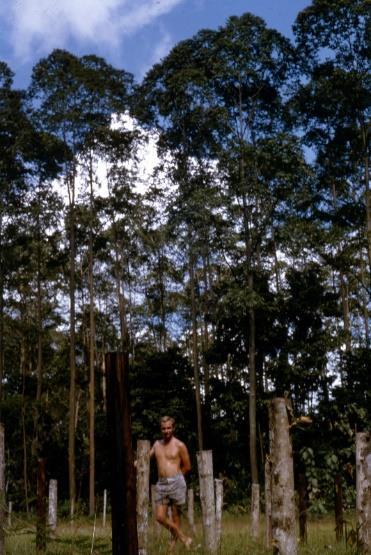
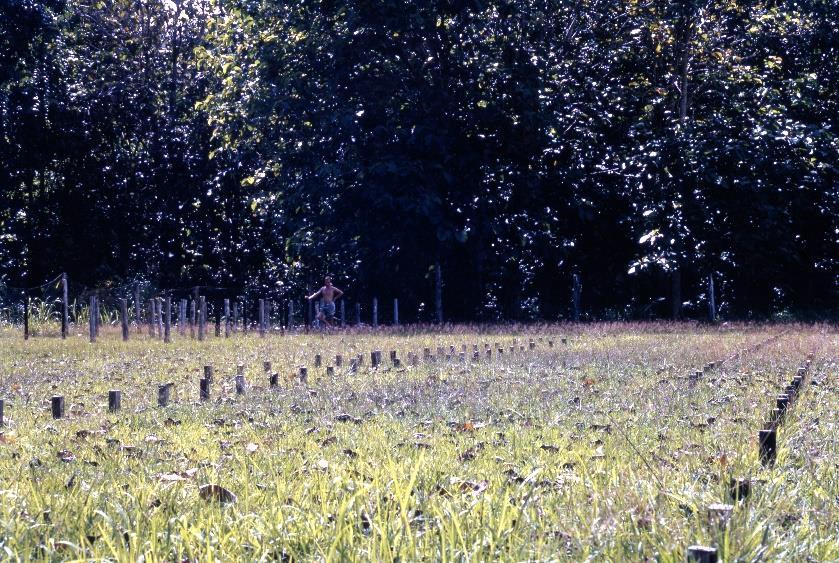
“Graveyard” timber durability trials CSIRO/TPNG Forests Dec 1967 Jan 1968 Bob Willis TA. Photo credit Ian Whyte.
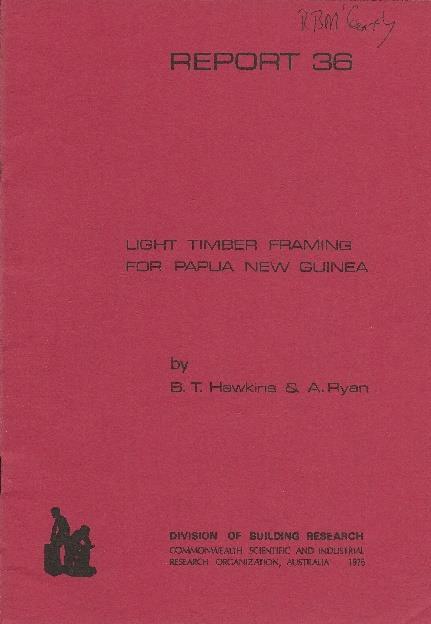
41
42
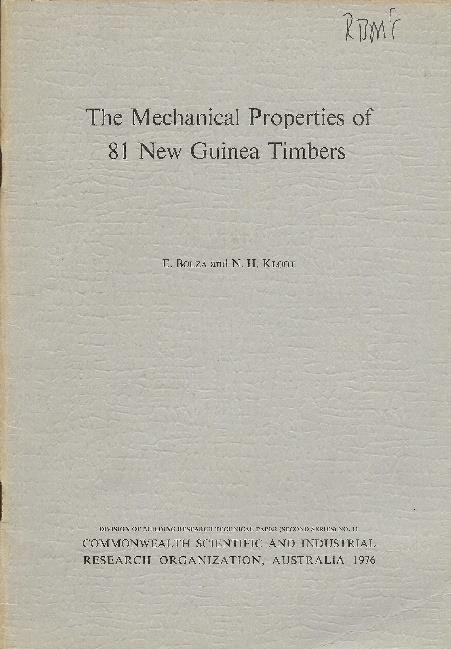
41 Hawkins BT & Ryan A 1975 Light timber framing for Papua New Guinea CSIRO Division of Building Research 42 Bolza E & Kloot N H 1976 The Mechanical Properties of 81 New Guinea Timbers CSIRO Building Research








